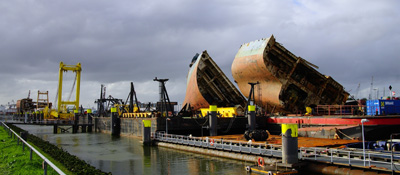Issue
The historic aircraft carrier INS Viraat, beached at Alang on September 28, will continue to stay in its place until a team of workers start dismantling it.
Details
- Usually, when a vessel is beached at Alang, it uses the force of high tide as well as its own engine power to glide on to the shore at speeds ranging between 15-20 knots.
- Viraat has been secured by iron ropes that are tied to diesel-powered wrenches. This ensures that the vessel does not tilt or change its position during tides and ebbs.
- The owners of Shree Ram Group which bought INS Viraat from an auction said their plots were “green ship recycling” yards which have certificates from Hong Kong Convention and European Union.
- As it is a green yard, it is ensured that the ship is not broken down in the sea and the entire vessel is broken once it is dragged to the shore. Cranes are also used to ensure that the broken parts do not fall into the sea.
- During high tide, the sea-facing wrenches which are connected with iron ropes fastened to the aircraft carrier will be switched on. These wrenches will slowly drag the warship to the empty space on the beach.
- The ship will need a “cutting permission” from the Gujarat Pollution Control Board and the Gujarat Maritime Board before the dismantling can commence. This will be done after a physical inspection of the ship by different agencies post-beaching.
- The oil in engines and other machinery have to be emptied. Old batteries have to be removed. Any flammable liquids including the left-over fuel in the tanks will have to be pumped out.
- These tanks have to be cleaned and made free of any residue gases accumulated inside the fuel tanks.
- Once the ship comes on the shore, an independent agency will prepare an Inventory of Hazardous Materials (IHM). This agency will go on-board, take all samples including the persistent organic pollutants (POPs).
- This IHM acts as a guide and the ship breaker makes marking on board the vessel indicating the hazardous portions of the ship. Then the HAZMAT (hazardous material) team of the ship breaker will remove the hazardous substances before the breaking begins.
- Once the cutting begins, hazardous substances like asbestos, batteries, and ozone-depleting gases will have to be tackled and disposed of safely.
- Being a naval ship, it not only has a double hull made of steel plates that are several inches thick but also has multiple small compartments which take time to cut and dismantle.
- Parts dismantled from ships at Alang are usually recycled or sold. As far as INS Viraat is concerned, automobile companies have already contacted the ship-breaker for the steel salvaged from the warship.






